Mauritius: 10 sights of the Colourful South
As an idyllic dot of paradise in the warm Indian Ocean, Mauritius has much more to offer than just white-sand beaches leading into the azure seas of a warm lagoon and catamaran cruises out beyond the coral reefs in search of dolphins and whales.
 Although Mauritius only has a brief history of human occupation it has many attractions, both natural and manmade. Arab sailors first discovered Mauritius around 950 but they did not settle nor did the Portuguese explorers who arrived in 1598. The Dutch were the first settlers, on an island without an indigenous population, but once the Dutch had felled the hard wood trees they wanted for furniture manufacture they departed.
Although Mauritius only has a brief history of human occupation it has many attractions, both natural and manmade. Arab sailors first discovered Mauritius around 950 but they did not settle nor did the Portuguese explorers who arrived in 1598. The Dutch were the first settlers, on an island without an indigenous population, but once the Dutch had felled the hard wood trees they wanted for furniture manufacture they departed.
 On your tour of the South you will see part of the French legacy, they planted the fields of sugar cane and named the towns. Then in 1810 the English defeated the French, introducing the English language and a love of tea with milk.
Many tourists base themselves on the breeze-cooled beaches of the north coast. Summertimes offer a excursion which allows them to catch-up on the many charms of Mauritius’ South in an action packed day.
Views from the volcano
As Mauritius was formed from a volcanic eruption the rim of the now extinct volcano, Trou-Aux-Cerfs, makes a logical starting point. There are panoramic views of black rock peaks and across the fertile landscape to Mauritius’ five main towns.
On your tour of the South you will see part of the French legacy, they planted the fields of sugar cane and named the towns. Then in 1810 the English defeated the French, introducing the English language and a love of tea with milk.
Many tourists base themselves on the breeze-cooled beaches of the north coast. Summertimes offer a excursion which allows them to catch-up on the many charms of Mauritius’ South in an action packed day.
Views from the volcano
As Mauritius was formed from a volcanic eruption the rim of the now extinct volcano, Trou-Aux-Cerfs, makes a logical starting point. There are panoramic views of black rock peaks and across the fertile landscape to Mauritius’ five main towns.
 Rising up alongside the crater is a new meteorological station. Mauritius has several microclimates and this high point, with plenty of showers, is a location selected for close study.
Model ship construction
Visit the model-ship factory at Voiliers de l’Ocean to watch craft-workers create replicas of many of the world’s great ships from plans imported from their country of origin.
Rising up alongside the crater is a new meteorological station. Mauritius has several microclimates and this high point, with plenty of showers, is a location selected for close study.
Model ship construction
Visit the model-ship factory at Voiliers de l’Ocean to watch craft-workers create replicas of many of the world’s great ships from plans imported from their country of origin.
 Currently the 17th Century “Sovereign of the Seas”, from Charles l’s English Navy, takes pride of place in the showroom with its balsa skeleton and tea-stained sails. After over 700 hours of labour the ship is on sale for 250,000 Mauritian Rupees (around £5,500). On average the shop sells around ten of this model a year.
Lychee wine
Mauritius’s summer humidity does not produce the quality of grapes needed for great wines so one innovative Mauritian winemaker had a highly original idea.
Currently the 17th Century “Sovereign of the Seas”, from Charles l’s English Navy, takes pride of place in the showroom with its balsa skeleton and tea-stained sails. After over 700 hours of labour the ship is on sale for 250,000 Mauritian Rupees (around £5,500). On average the shop sells around ten of this model a year.
Lychee wine
Mauritius’s summer humidity does not produce the quality of grapes needed for great wines so one innovative Mauritian winemaker had a highly original idea.
 Taste lychee wines at Takamaka Boutique winery. Winemaker Alexander Oxenham is making good progress developing a dry white and a sweet wine. A rosé, coloured by the red skin of the fruit, is a heady wine, pairing well with the spicy flavours of Mauritian cuisine.
Hindu gods and temples
After the Abolition of Slavery in 1825, the British colonial rulers looked to India for indentured workers for labour on the sugar cane plantations.
Consequently, today 52% of Mauritius’ population follow the Hindu faith. The 33 metre tall statue of Shiva, cast in concrete was a gift from the Indian government. But the Mauritians decided he needed his wife, and commissioned a second statue. Her many hands represent her many reincarnations.
Taste lychee wines at Takamaka Boutique winery. Winemaker Alexander Oxenham is making good progress developing a dry white and a sweet wine. A rosé, coloured by the red skin of the fruit, is a heady wine, pairing well with the spicy flavours of Mauritian cuisine.
Hindu gods and temples
After the Abolition of Slavery in 1825, the British colonial rulers looked to India for indentured workers for labour on the sugar cane plantations.
Consequently, today 52% of Mauritius’ population follow the Hindu faith. The 33 metre tall statue of Shiva, cast in concrete was a gift from the Indian government. But the Mauritians decided he needed his wife, and commissioned a second statue. Her many hands represent her many reincarnations.
 Beyond the two giant gods a short walk takes you to ‘Ganga Talao’ – a lake sacred to Mauritian Hindus in Plaine Champagne. Amongst the incense scented air two temples sit on the banks of the serene lake.
Black River Gorges National Park
Macaque monkeys gather on the walls overlooking a waterfall and what remains of Mauritius’ ancient forests. The monkeys are drawn by the bananas the visitors provide.
Beyond the two giant gods a short walk takes you to ‘Ganga Talao’ – a lake sacred to Mauritian Hindus in Plaine Champagne. Amongst the incense scented air two temples sit on the banks of the serene lake.
Black River Gorges National Park
Macaque monkeys gather on the walls overlooking a waterfall and what remains of Mauritius’ ancient forests. The monkeys are drawn by the bananas the visitors provide.
 It is estimated that just 1.3% of the original forests remains. Dutch settlers operated a lucrative trade in the hardwoods of mahogany, rosewood and teak, that were so fashionable for 17th Century furniture. With Rosewood growing at just 1 cm per year replenishing these forests will take centuries.
Lunch with a view
The Chamarel restaurant, reached by the Anaconda road which has 52 snaking curves, gives beautiful views of the shoreline and sea beyond.
It is estimated that just 1.3% of the original forests remains. Dutch settlers operated a lucrative trade in the hardwoods of mahogany, rosewood and teak, that were so fashionable for 17th Century furniture. With Rosewood growing at just 1 cm per year replenishing these forests will take centuries.
Lunch with a view
The Chamarel restaurant, reached by the Anaconda road which has 52 snaking curves, gives beautiful views of the shoreline and sea beyond.
 The cuisine is light and typically Mauritian with the popular Blue Marlin as a starter then hake or chicken for the main course. Mauritius’ high proportion of Hindus means that beef rarely dominates menus.
Coconuts
Watch a muscular man with his machete slice open a coconut in the palm of his hand. Remarkably he still has all five fingers on his hand.
The cuisine is light and typically Mauritian with the popular Blue Marlin as a starter then hake or chicken for the main course. Mauritius’ high proportion of Hindus means that beef rarely dominates menus.
Coconuts
Watch a muscular man with his machete slice open a coconut in the palm of his hand. Remarkably he still has all five fingers on his hand.
 Nothing is wasted. The hairy husk is put on the sugar cane plantations as a fertiliser, coconut water is drunk, the flesh is eaten whilst the shells are fashioned into bowls and glazed.
The Chamarel Waterfalls
An information board points out that at a height of around 100 metres the Chamarel Waterfalls are almost the same height as New York’s Statue of Liberty.
Nothing is wasted. The hairy husk is put on the sugar cane plantations as a fertiliser, coconut water is drunk, the flesh is eaten whilst the shells are fashioned into bowls and glazed.
The Chamarel Waterfalls
An information board points out that at a height of around 100 metres the Chamarel Waterfalls are almost the same height as New York’s Statue of Liberty.
 The Mauritian summer, from November to April, when rainfall is higher, sees the Falls at their most spectacular. Waters cascade down against a scenic backdrop of luxuriant forests and dark mountains.
Coloured earth
Summertimes’ day excursion calls in on the “Seven Coloured Earths” which is the economy version. The south coast actually comprises of 23 coloured earths.
The Mauritian summer, from November to April, when rainfall is higher, sees the Falls at their most spectacular. Waters cascade down against a scenic backdrop of luxuriant forests and dark mountains.
Coloured earth
Summertimes’ day excursion calls in on the “Seven Coloured Earths” which is the economy version. The south coast actually comprises of 23 coloured earths.
 The phenomenon was created, after the volcanic eruption, by the earth cooling at different rates and at different times.
The phenomenon was created, after the volcanic eruption, by the earth cooling at different rates and at different times.
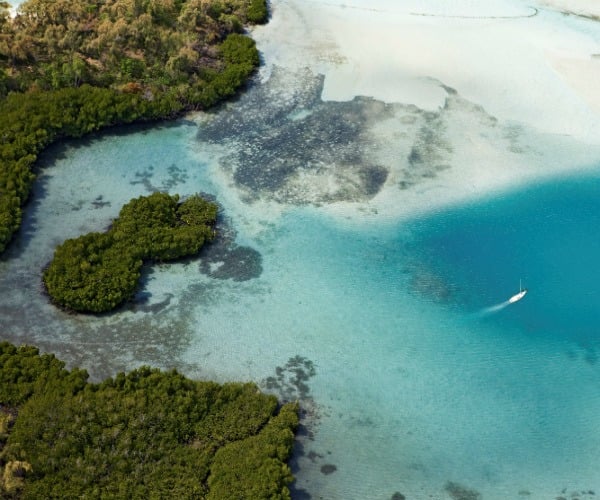 Although Mauritius only has a brief history of human occupation it has many attractions, both natural and manmade. Arab sailors first discovered Mauritius around 950 but they did not settle nor did the Portuguese explorers who arrived in 1598. The Dutch were the first settlers, on an island without an indigenous population, but once the Dutch had felled the hard wood trees they wanted for furniture manufacture they departed.
Although Mauritius only has a brief history of human occupation it has many attractions, both natural and manmade. Arab sailors first discovered Mauritius around 950 but they did not settle nor did the Portuguese explorers who arrived in 1598. The Dutch were the first settlers, on an island without an indigenous population, but once the Dutch had felled the hard wood trees they wanted for furniture manufacture they departed.
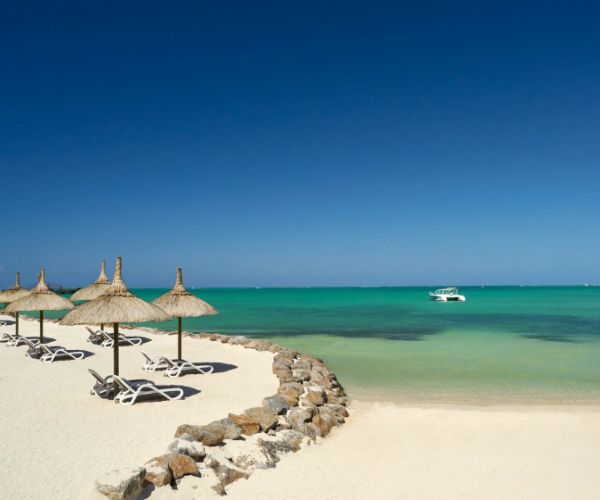 On your tour of the South you will see part of the French legacy, they planted the fields of sugar cane and named the towns. Then in 1810 the English defeated the French, introducing the English language and a love of tea with milk.
Many tourists base themselves on the breeze-cooled beaches of the north coast. Summertimes offer a excursion which allows them to catch-up on the many charms of Mauritius’ South in an action packed day.
Views from the volcano
As Mauritius was formed from a volcanic eruption the rim of the now extinct volcano, Trou-Aux-Cerfs, makes a logical starting point. There are panoramic views of black rock peaks and across the fertile landscape to Mauritius’ five main towns.
On your tour of the South you will see part of the French legacy, they planted the fields of sugar cane and named the towns. Then in 1810 the English defeated the French, introducing the English language and a love of tea with milk.
Many tourists base themselves on the breeze-cooled beaches of the north coast. Summertimes offer a excursion which allows them to catch-up on the many charms of Mauritius’ South in an action packed day.
Views from the volcano
As Mauritius was formed from a volcanic eruption the rim of the now extinct volcano, Trou-Aux-Cerfs, makes a logical starting point. There are panoramic views of black rock peaks and across the fertile landscape to Mauritius’ five main towns.
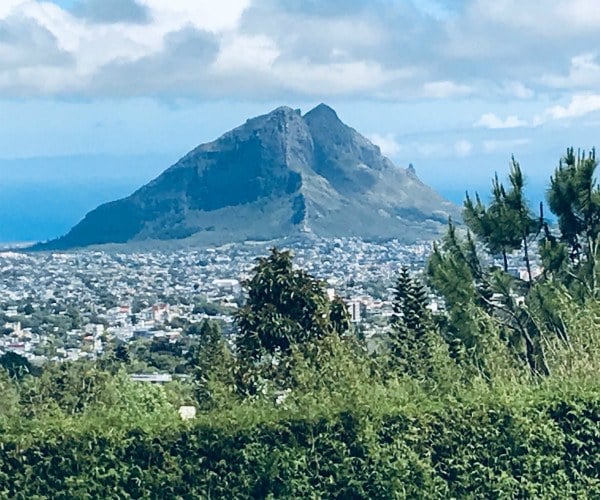 Rising up alongside the crater is a new meteorological station. Mauritius has several microclimates and this high point, with plenty of showers, is a location selected for close study.
Model ship construction
Visit the model-ship factory at Voiliers de l’Ocean to watch craft-workers create replicas of many of the world’s great ships from plans imported from their country of origin.
Rising up alongside the crater is a new meteorological station. Mauritius has several microclimates and this high point, with plenty of showers, is a location selected for close study.
Model ship construction
Visit the model-ship factory at Voiliers de l’Ocean to watch craft-workers create replicas of many of the world’s great ships from plans imported from their country of origin.
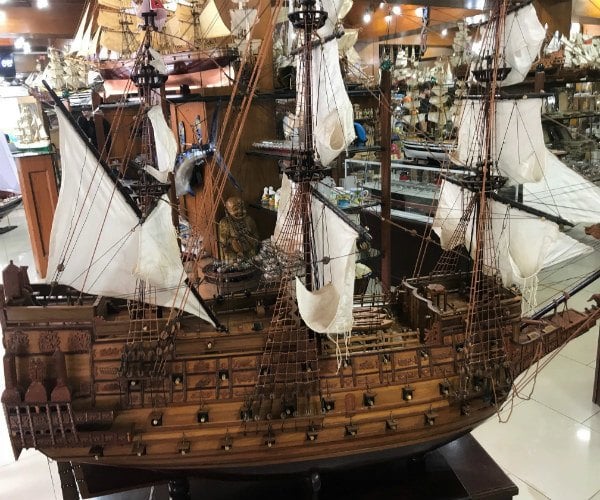 Currently the 17th Century “Sovereign of the Seas”, from Charles l’s English Navy, takes pride of place in the showroom with its balsa skeleton and tea-stained sails. After over 700 hours of labour the ship is on sale for 250,000 Mauritian Rupees (around £5,500). On average the shop sells around ten of this model a year.
Lychee wine
Mauritius’s summer humidity does not produce the quality of grapes needed for great wines so one innovative Mauritian winemaker had a highly original idea.
Currently the 17th Century “Sovereign of the Seas”, from Charles l’s English Navy, takes pride of place in the showroom with its balsa skeleton and tea-stained sails. After over 700 hours of labour the ship is on sale for 250,000 Mauritian Rupees (around £5,500). On average the shop sells around ten of this model a year.
Lychee wine
Mauritius’s summer humidity does not produce the quality of grapes needed for great wines so one innovative Mauritian winemaker had a highly original idea.
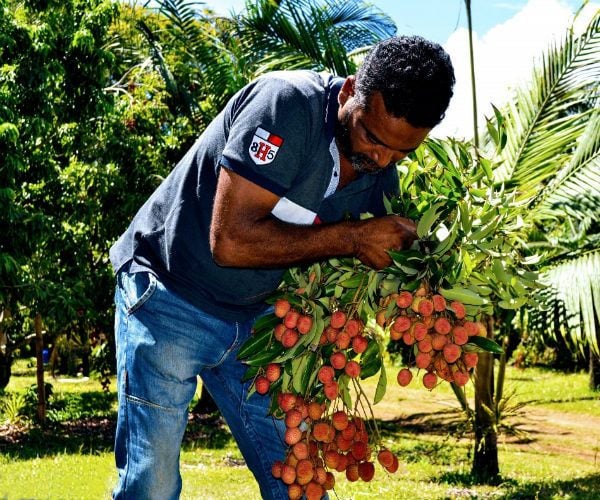 Taste lychee wines at Takamaka Boutique winery. Winemaker Alexander Oxenham is making good progress developing a dry white and a sweet wine. A rosé, coloured by the red skin of the fruit, is a heady wine, pairing well with the spicy flavours of Mauritian cuisine.
Hindu gods and temples
After the Abolition of Slavery in 1825, the British colonial rulers looked to India for indentured workers for labour on the sugar cane plantations.
Consequently, today 52% of Mauritius’ population follow the Hindu faith. The 33 metre tall statue of Shiva, cast in concrete was a gift from the Indian government. But the Mauritians decided he needed his wife, and commissioned a second statue. Her many hands represent her many reincarnations.
Taste lychee wines at Takamaka Boutique winery. Winemaker Alexander Oxenham is making good progress developing a dry white and a sweet wine. A rosé, coloured by the red skin of the fruit, is a heady wine, pairing well with the spicy flavours of Mauritian cuisine.
Hindu gods and temples
After the Abolition of Slavery in 1825, the British colonial rulers looked to India for indentured workers for labour on the sugar cane plantations.
Consequently, today 52% of Mauritius’ population follow the Hindu faith. The 33 metre tall statue of Shiva, cast in concrete was a gift from the Indian government. But the Mauritians decided he needed his wife, and commissioned a second statue. Her many hands represent her many reincarnations.
 Beyond the two giant gods a short walk takes you to ‘Ganga Talao’ – a lake sacred to Mauritian Hindus in Plaine Champagne. Amongst the incense scented air two temples sit on the banks of the serene lake.
Black River Gorges National Park
Macaque monkeys gather on the walls overlooking a waterfall and what remains of Mauritius’ ancient forests. The monkeys are drawn by the bananas the visitors provide.
Beyond the two giant gods a short walk takes you to ‘Ganga Talao’ – a lake sacred to Mauritian Hindus in Plaine Champagne. Amongst the incense scented air two temples sit on the banks of the serene lake.
Black River Gorges National Park
Macaque monkeys gather on the walls overlooking a waterfall and what remains of Mauritius’ ancient forests. The monkeys are drawn by the bananas the visitors provide.
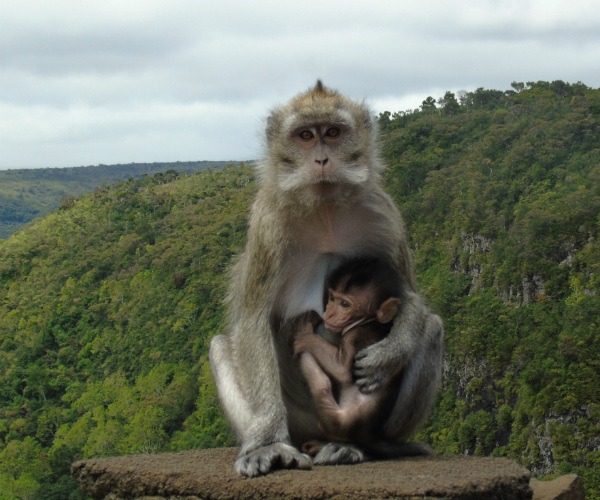 It is estimated that just 1.3% of the original forests remains. Dutch settlers operated a lucrative trade in the hardwoods of mahogany, rosewood and teak, that were so fashionable for 17th Century furniture. With Rosewood growing at just 1 cm per year replenishing these forests will take centuries.
Lunch with a view
The Chamarel restaurant, reached by the Anaconda road which has 52 snaking curves, gives beautiful views of the shoreline and sea beyond.
It is estimated that just 1.3% of the original forests remains. Dutch settlers operated a lucrative trade in the hardwoods of mahogany, rosewood and teak, that were so fashionable for 17th Century furniture. With Rosewood growing at just 1 cm per year replenishing these forests will take centuries.
Lunch with a view
The Chamarel restaurant, reached by the Anaconda road which has 52 snaking curves, gives beautiful views of the shoreline and sea beyond.
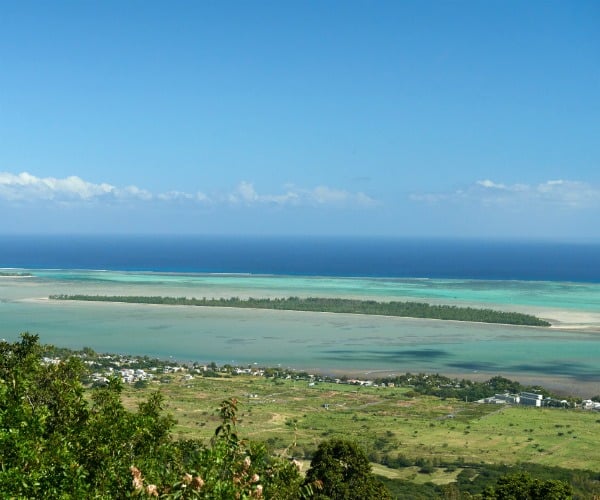 The cuisine is light and typically Mauritian with the popular Blue Marlin as a starter then hake or chicken for the main course. Mauritius’ high proportion of Hindus means that beef rarely dominates menus.
Coconuts
Watch a muscular man with his machete slice open a coconut in the palm of his hand. Remarkably he still has all five fingers on his hand.
The cuisine is light and typically Mauritian with the popular Blue Marlin as a starter then hake or chicken for the main course. Mauritius’ high proportion of Hindus means that beef rarely dominates menus.
Coconuts
Watch a muscular man with his machete slice open a coconut in the palm of his hand. Remarkably he still has all five fingers on his hand.
 Nothing is wasted. The hairy husk is put on the sugar cane plantations as a fertiliser, coconut water is drunk, the flesh is eaten whilst the shells are fashioned into bowls and glazed.
The Chamarel Waterfalls
An information board points out that at a height of around 100 metres the Chamarel Waterfalls are almost the same height as New York’s Statue of Liberty.
Nothing is wasted. The hairy husk is put on the sugar cane plantations as a fertiliser, coconut water is drunk, the flesh is eaten whilst the shells are fashioned into bowls and glazed.
The Chamarel Waterfalls
An information board points out that at a height of around 100 metres the Chamarel Waterfalls are almost the same height as New York’s Statue of Liberty.
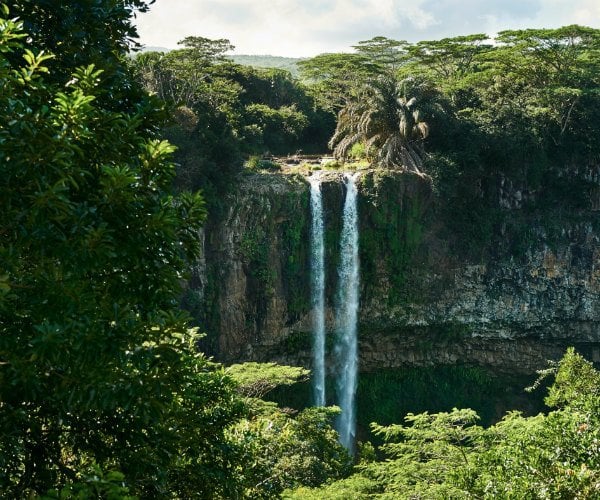 The Mauritian summer, from November to April, when rainfall is higher, sees the Falls at their most spectacular. Waters cascade down against a scenic backdrop of luxuriant forests and dark mountains.
Coloured earth
Summertimes’ day excursion calls in on the “Seven Coloured Earths” which is the economy version. The south coast actually comprises of 23 coloured earths.
The Mauritian summer, from November to April, when rainfall is higher, sees the Falls at their most spectacular. Waters cascade down against a scenic backdrop of luxuriant forests and dark mountains.
Coloured earth
Summertimes’ day excursion calls in on the “Seven Coloured Earths” which is the economy version. The south coast actually comprises of 23 coloured earths.
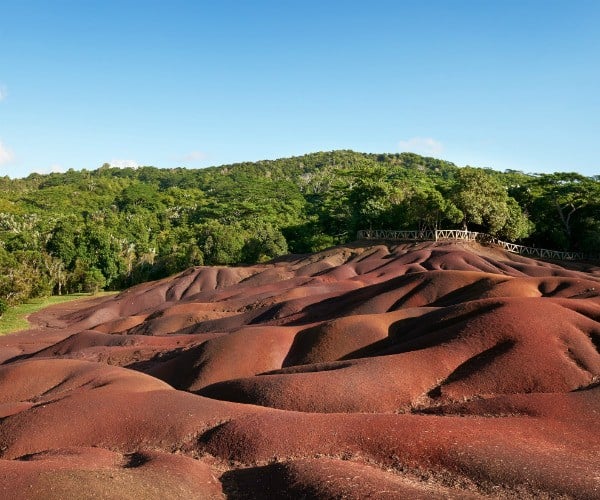 The phenomenon was created, after the volcanic eruption, by the earth cooling at different rates and at different times.
The phenomenon was created, after the volcanic eruption, by the earth cooling at different rates and at different times.Did you enjoy this article?
Receive similar content direct to your inbox.



I have visited Mauritius on a number of occasions and I have been hugely impressed. The hospitality industry is world class. Consequently tourism is now the most significant industry.
This looks to be a typically slick Mauritian Tour. It is a relatively small island, only about the size of Surrey, but there is much to see. This tour packs in many of the highlights.
Personally, I would have liked to have seen a rum distillery included as well. Sugar and Rum are key industries for Mauritius – and I am never adverse to a tot of Rum. However, travel can be slow on the island and I can understand that there may have been time pressures.
Love the idea of the Lychee Wine. How creative is that? Maybe if we made more of local resources, with some imagination like this, we could reallly reduce food miles. I bet the Lychee orchards are a spectacular sight.
This post suggests that Mauritius is packed with activities. I know that nearly everyone has it on their “Must visit” list but there is much more to do than just lie on the beach or sail around the breathtaking coastline.
Yes, I know that I’m a “Travel Nerd”, full of irrelevant trivia. But it is relevant that Mauritius is one of the safest destinations in the world. The island is just one of four countries in the world not involved in any dispute with other nations. It does help when you are so far away from everywhere else.
More importantly Hindus, Moslems and Christians get on. Mauritius never had an indigenous population. That means everyone is from somewhere else. No one’s saying “This is our country” you shouldn’t be here. That makes for a very safe and relaxing environment.
I didn’t know that Lychee wines are also made in Mauritius. I’ve only ever had (and tasted) them when I visited China. The wines are really sweet and I consider them dessert wine rather than having it with a main meal.
Takamaka produce a very sweet white Lychee wine and I didn’t like it, I just don’t do sweet wine. I tried the dry white which was excellent. In a blind tasting you would have probably thought that it was something like an Italian wine. Though in my humble opinion, and also of the dozen people I was with, the Rose is the star. Currently Takamaka are increasing domestic production but then hope to target the export market.
One of the key attractions of the island is the Casela Adventure Park. The one and only of its kind outdoor park in Mauritius. But I would highly recommend anyone who is looking forward to spend a day at Casela to check the weather forecasts for the day. And its best to plan a trip here on a clear, sunny day to make the most of the park’s facilities. Because when it is raining most of the amusement activities (though not all) particularly zip-lining, coaster and other adrenaline rides cease their activity.